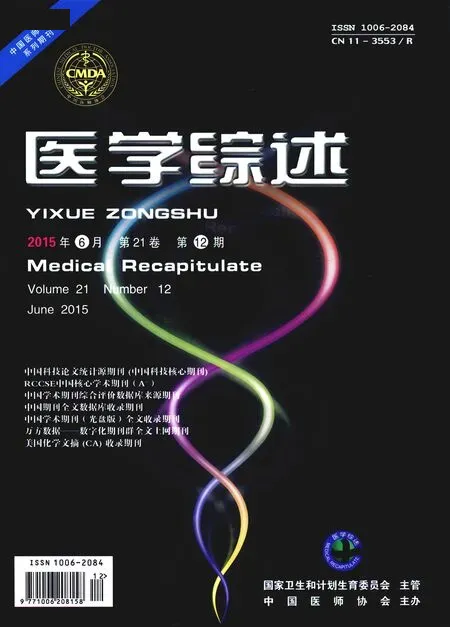肿瘤干细胞和上皮-间质转化之间的关系及其在肿瘤侵袭转移中的作用
艾军华(综述),时 军(审校)
(1.南昌大学第一附属医院普外科,南昌 330006; 2.武警8710部队医院外科,福建 莆田 351133)
肿瘤干细胞和上皮-间质转化之间的关系及其在肿瘤侵袭转移中的作用
艾军华1,2(综述),时 军1※(审校)
(1.南昌大学第一附属医院普外科,南昌 330006; 2.武警8710部队医院外科,福建 莆田 351133)
肿瘤干细胞(CSCs)是肿瘤中能通过分化成异源的癌细胞系而具有自我更新并保持肿瘤启动能力的细胞。近年来研究表明,CSCs是肿瘤治疗后复发转移的起源细胞。上皮-间质转化(EMT)可产生与CSCs分子特征相同的细胞,而且EMT与肿瘤侵袭转移有关,是开启早期肿瘤进入侵袭性恶性表型的关键过程。因此,开发阻止肿瘤细胞发生EMT的治疗策略,将不仅可从源头上消灭肿瘤复发的“种子”,还可抑制早期肿瘤进展为侵袭性表型的过程,从而达到有效防治恶性肿瘤术后复发的目的。
上皮-间质转化;肿瘤干细胞样细胞;肿瘤启动细胞;药物抗性
上皮-间质转化(epithelial-to-mesenchymal transition, EMT)作为胚胎发育的特征首先被认识。研究表明,EMT参与早期肿瘤进展为侵袭性恶性肿瘤的过程[1],而且EMT能使肿瘤细胞获得浸润周围组织的能力,并使肿瘤细胞转移到远处器官[2]。大部分癌症的进展与间叶表型的获得相关,并伴有上皮标志物表达的丧失和间叶标志物的上调,从而导致细胞移动和侵袭能力增强[3]。肿瘤的发生和复发被认为与肿瘤干细胞(cancer stem cells, CSCs)或肿瘤启动细胞的生物学特性密切相关[4-5],而且由不同因子诱导、具有EMT表型的细胞是肿瘤干细胞样细胞的丰富来源[6]。肿瘤细胞中EMT的诱导不仅促进肿瘤细胞侵袭和转移而且有助于药物抗性[7-9]。因此阐明这些细胞的分子特征将有助于开发新的、完全消灭肿瘤的新方法。现对CSCs和EMT之间的关系及其在肿瘤侵袭转移中的作用进行综述。
1 EMT在肿瘤进展和转移中的作用
EMT是指上皮细胞在特定的情况下向间质细胞转分化的现象[10],EMT过程对癌症进展和转移是非常重要的。实体肿瘤细胞通过空间和时间上的EMT而进展为更具侵袭性的表型。具有间叶表型的转移瘤细胞经过相反的过程,即转移部位的间叶-上皮转化(mesenchymal-to-epithelial transition, MET)后获得对应的原发瘤病理学特征,MET过程是关键的一步,通过MET转移瘤细胞在第二部位生长。研究表明,原发性结肠癌及其转移癌显示出一种混合的上皮-间叶表型[11]。在肿瘤中心的细胞仍表达上皮性钙黏蛋白(E-cadherin)和胞质β-联蛋白(β-catenin),而在周围的肿瘤细胞显示出表面E-cadherin丧失和波形蛋白(Vimentin)上调及核β-catenin 表达,即典型的EMT表型特征。Chaffer等[12]用膀胱癌非雄激素依赖型前列腺癌(TSU-prl, T24)系列细胞株筛选转移能力增强的细胞,发现转移能力更强的细胞亚群具有EMT特征。在前列腺癌,Yates等[13]用DU145)或PC3细胞与肝细胞共培养,发现在共培养条件下紧密连接处周围的DU145和PC3细胞的E-cadherin表达上调,而且这些细胞系显示出细胞-细胞间黏附连接如E-cadherin分子标志物的表达与上皮样形态是相同的。这些结果表明,细胞中EMT表型改变有助于肿瘤侵袭。
2 CSCs的发现
CSCs是肿瘤中具有自我更新并分化成一个完整肿瘤所必需的所有异源肿瘤细胞系的细胞。CSCs的存在首先在白血病细胞中分离并被证实[14]。他们发现仅有一小部分具有CD34+CD38-细胞表面标志物的白血病细胞亚群移植到严重联合免疫缺陷的小鼠身上,才能导致癌症扩散和白血病细胞形态与原发灶中的癌细胞形态相似。此后CSCs在实体肿瘤如乳腺癌、结肠癌、脑肿瘤和前列腺癌中被鉴定出来。Ricci-Vitiani 等[15]发现,105个CD133-结肠癌细胞并不能诱导肿瘤形成,而在基质胶中注入106个结肠癌细胞悬液5周后可产生肉眼可见的肿瘤,而注入3000个CD133+结肠癌细胞4周后即可诱导生成肉眼可见的肿瘤。O′Brien等[16]也发现,262个CD133+结肠癌细胞能诱导严重联合免疫缺陷小鼠肿瘤形成。这些结果表明,结肠癌启动细胞是CD133+结肠癌细胞。用中枢干细胞表面标志物CD133分离到了大脑肿瘤干细胞,从侵袭性很强的髓母细胞瘤的临床标本中分离的细胞亚群具有增强的自我更新能力[17-18]。这些CD133+细胞在培养基中能分化成形态类似于癌症患者中的肿瘤细胞。他们还发现在非肥胖糖尿病、严重联合免疫缺陷小鼠大脑中注入100个 CD133+细胞可诱导肿瘤发生。在人前列腺癌中,Patrawala等[19]从用CD44表面标志物建立的异种移植物中鉴定出了肿瘤启动细胞,并用CD44+α2β1+筛选充实了这些细胞。研究表明,多潜能标志物如Oct4、Sox2、Nanog、lin28、Klf4和c-myc 的共表达能重新编程体细胞成为多潜能的胚胎干细胞样细胞,说明干细胞相关的因子和癌基因的联合表达也可诱导这些细胞呈未分化状态[20]。Jeter等[21]发现,来源于人、具有上皮表型的前列腺细胞可被人端粒酶逆转录酶永生化并且表达胚胎干细胞标志物如Oct4、Nanog和Sox2,这与分化差的肿瘤中Oct4、Sox2、Nanog和c-myc过表达的结果是一致的,而Nanog、Sox2和Oct4在癌症进展中发挥重要作用[22-24]。
3 EMT表型细胞是CSCs的起源细胞
大部分肿瘤向恶性进展与上皮分化的丧失和以增强的细胞移动和侵袭为特征的间叶表型的获得相关,并促进肿瘤转移和耐药[9]。研究表明,EMT不仅在肿瘤转移而且在肿瘤复发中发挥重要作用,这与CSCs的生物学特性密切相关[25-31]。Morel等[32]发现,CD44+CD24-/low干细胞样细胞特征能通过激活膜受体酪氨酸蛋白激酶Ras/丝裂原活化蛋白激酶(Ras/mitogen-activated protein kinase, Ras/MAPK)信号通路从一种非肿瘤性乳腺上皮细胞CD44lowCD24+细胞产生。他们还发现CD44+CD24-/low细胞显示出E-cadherin表达丧失和Vimentin表达获得为特征的EMT表型,因而假设EMT的诱导可能与CD44lowCD24+细胞转化为CD44+CD24-/low干细胞样细胞有关。用转化生长因子β处理CD24+细胞,处理后8 d出现CD24-细胞,伴随以E-cadherin丧失和Vimentin表达为特征的间叶表型细胞增多。Mani等[33]进一步研究表明,由twist或snail诱导非肿瘤、永生化的人乳腺上皮细胞成EMT表型将导致上皮表型丧失并获得间叶表型,同时获得CD44high/CD24low表达模式并增加微球体形成能力和肿瘤启动能力。但是,从正常和恶性人乳腺细胞分离出来的CD44high/CD24low干细胞样细胞显示出间叶形态并表达间叶标志物如Vimentin和纤维连接蛋白。Santisteban等[34]观察到由一种上皮乳腺癌产生的免疫应答诱导的EMT可引起体内肿瘤过度生长。而且间叶性肿瘤细胞有CD44+CD24-/low表型,该表型能重建上皮肿瘤并增加耐药性,这些与乳腺CSCs的特征一致。Gupta等[35]也发现由短发夹RNA(short hairpin RNA, shRNA)介导的E-cadherin敲除诱导转化的HMLER。乳腺癌细胞发生EMT后CD44high/CD24low细胞数量增加,并且与它们的上皮表型细胞相比这些细胞显示出了增强100倍的微球体形成能力。这些报道均提示EMT能诱导产生干细胞样细胞,但调控该过程的分子机制还不完全清楚。
4 miRNAs以干细胞特征联系EMT
已知微RNA(microRNAs,miRNAs)参与胚胎发育和癌症进展[36],而癌症进展与上皮肿瘤细胞EMT有关。miRNAs是一类小的非编码RNA分子,通过与靶基因的3′-非翻译区(3′untranslated Regions, 3′UTR)序列相互作用下调基因表达,从而导致翻译抑制或mRNAs降解[37]。研究表明,miR-200 家族成员能通过结合锌指E-盒结合同源异形盒(zinc-finger E-box binding homeobox 1, ZEB1)、锌指E-盒结合同源异形盒(zinc-finger E-box binding homeobox 2, ZEB2) mRNA的3′UTR序列调控ZEB1和ZEB2的表达进而调控EMT过程[38]。ZEB1和ZEB2能通过直接结合miR-200基因中E-盒的结合位点抑制miR-200家族的表达,从而在EMT过程中建立一个调控ZEB1、ZEB2和miR-200家族的双向负反馈环。miR-200也可通过调控B细胞特异性白血病病毒插入位点(B-cell-specific moloney leukemia virus insert sitel, Bmil)、Notch1和Lin28B的表达与干细胞样细胞特征有关[39]。Wellner等[40]发现EMT活化因子ZEB1在低分化的人胰腺癌中高表达,并且用表达ZEB1的Panc1细胞原位注射至胰腺内导致裸鼠胰腺形成一个大的原发肿瘤并侵犯胃、脾脏、小肠和大肠,并转移到淋巴结和肝脏。而用敲除了ZEB1的细胞注射引起一个更小的原发肿瘤,且该原发瘤没有局部浸润、淋巴结转移和远处转移。此外ZEB1不仅抑制miR-200c表达而且也通过抑制miR-203和miR-183表达而调控干细胞性相关的因子如Bmil、Sox2和Klf4表达。这些报道均表明miR-200 家族与EMT调控、CSCs和干细胞样细胞特征的维持有直接关系。
Iliopoulos等[41]发现,蛋白激酶(Akt)的3个异构体通过调控miR-200家族的表达诱导EMT发挥相反的作用。同时,在小鼠乳腺肿瘤病毒(mouse mammary tumor virus, MMTV)-cErbB2/Akt1-/-小鼠生长的肿瘤显示出miR-200下调和侵袭能力增加。因此,是Akt-1/Akt2比例而不是Akt的总活性能通过调控miR-200家族的表达而控制EMT的诱导及维持肿瘤细胞的干细胞性。他们还发现miR-200家族在CSCs诱导过程中也被抑制,但在携带可诱导的Src致癌基因的MCF-10A 模型中不转化,并且抑制miR-200b显示CSCs形成能力增强,且miR-200b直接靶向zeste 12抑制因子(suppressor of zeste 12, Suz12)[42]。
研究发现由血小板源性生长因子-D过表达诱导发生EMT的PC3细胞具有自我更新和肿瘤生成能力等干细胞特征,这与干细胞标志物如Notch-1、Sox2、Nanog、Oct4 和Lin28B表达增强是一致的[38-39,43]。这些EMT表型细胞也显示miR-200 或let-7家族表达下调。此外由转染miR-200前体迫使miR-200再表达诱导的EMT逆转明显抑制集落和前列腺生成能力,这与Notch-1和Lin28B表达下调有关。而敲除Lin28B明显增强let-7表达并减弱自我更新能力。在发生EMT的ARCaPM细胞中miR-200c表达被抑制,并且miR-200c 再表达逆转EMT表型至与Notch-1表达下调、ARCaRM细胞自我更新能力相关的MET表型[39]。这些报道均提示miRNAs尤其是miR-200家族成员把EMT表型与干细胞特性联系在一起,见表1。
5 展 望
传统的癌症治疗主要靶向分化的肿瘤细胞,但是在相当一部分癌症患者中,在规范治疗后癌细胞获得耐药表型,导致无法根治的肿瘤复发和远处转移。肿瘤复发被认为与CSCs或癌启动细胞的生物学特性密切相关[4]。越来越多的证据表明,肿瘤侵袭特性的获得与肿瘤细胞发生EMT有关,这允许
EMT:上皮-间质转化;CSCs:肿瘤干细胞;miRNAs:微RNAs;miR-200a:微RNA-200a;Akt-1:蛋白激酶B1;miR-200:微RNA-200;miR-200b:微RNA-200b;Notch1:Notch受体1;Suz12:zeste 12抑制因子;miR-200c:微miRNA-200c;miR-183:微RNA-183;ZEB1:锌指E-盒结合同源异形盒;ZEB2:锌指E-盒结合同源异形盒;Bmil:B细胞特异性白血病病毒插入位点;Sox2:Sry相关高迁移族蛋白盒2;KLF4:Krüppel样因子4
肿瘤细胞打破组织架构强加的结构限制[44]。EMT诱导的干细胞样细胞或CSCs为癌症复发提供种子,并且已知这些细胞高度耐药[36]。因此,鉴定哪些因子可能诱导EMT并阐明这些因子在癌症进展中的分子机制很重要,这强调了这些因子对开发新的完全治愈癌症的靶向治疗的重要性。阐明CSCs、肿瘤干细胞样细胞和EMT表型细胞的分子机制及生物学特性将有助于筛选出能选择性杀死这些细胞以消除肿瘤复发的潜在药物。
[1] Thiery JP.Epithelial-mesenchymal transitions in tumour progression[J].Nat Rev Cancer,2002,2(6):442-454.
[2] Madka V,Rao CV.Cancer stem cell markers as potential targets for epithelial cancers[J].Indian J Exp Biol,2011,49(11):826-835.
[3] Hollier BG,Evans K,Mani SA.The epithelial-to-mesenchymal transition and cancer stem cells:A coalition against cancer therapies[J].J Mammary Gland Biol Neoplasia,2009,14(1):29-43.
[4] Kasper S.Dentification,characterization,and biological relevance of prostate cancer stem cells from clinical specimens[J].Urol Oncol,2009,27(3):301-303.
[5] Marian CO,Shay JW.Prostate tumor-initiating cells:a new target for telomerase inhibition therapy? [J].Biochim Biophys Acta,2009,1792(4):289-296.
[6] Peter ME.Let-7 and miR-200 microRNAs:Guardians against pluripotency and cancer progression[J].Cell Cycle,2009,8(6):843-852.
[7] Sarkar FH,Li Y,Wang Z,etal.The role of nutraceuticals in the regulation of Wnt and Hedgehog signaling in cancer[J].Cancer Metastasis Rev,2010,29(3):383-394.
[8] Singh A,Settleman J.EMT,cancer stem cells and drug resistance:An emerging axis of evil in the war on cancer[J].Oncogene,2010,29(34):4741-4751.
[9] Wang Z,Li Y,Ahmad A,etal.Targeting miRNAs involved in cancer stem cell and EMT regulation:An emerging concept in overcoming drug resistance[J].Drug Resist Updat,2010,13(4/5):109-118.
[10] Oishi N,Wang XW.Novel therapeutic strategies for targeting liver cancer stem cells[J].Int J Sci,2011,7(5):517-535.
[11] Brabletz T,Jung A, Reu S,etal.Variable beta-catenin expression in colorectal cancers indicates tumor progression driven by the tumor environment[J].Proc Natl Acad Sci U S A,2001,98(18):10356-10361.
[12] Chaffer CL,Brennan JP,Slavin JL,etal.Mesenchymal-to-epithelial transition facilitates bladder cancer metastasis:Role of fibroblast growth factor receptor-2[J].Cancer Res,2006,66(23):11271-
11278.
[13] Yates CC,Shepard CR,Stolz DB,etal.Co-culturing human prostate carcinoma cells with hepatocytes leads to increased expression of E-cadherin[J].Br J Cancer,2007,96(8):1246-1252.
[14] Lapidot T,Sirard C,Vormoor J,etal.A cell initiating human acute myeloid leukaemia after transplantation into SCID mice[J].Nature,1994,367(6464):645-648.
[15] Ricci-Vitiani L,Lombardi DG,Pilozzi E,etal.Identification and expansion of human colon-cancer-initiating cells[J].Nature,2007,445(7123):111-115.
[16] O′Brien CA,Pollett A,Gallinger S,etal.A human colon cancer cell capable of initiating tumour growth in immunodeficient mice[J].Nature,2007,445(7123):106-110.
[17] Singh SK,Hawkins C,Clarke ID,etal.Identification of human brain tumour initiating cells[J].Nature,2004,432(7015):396-401.
[18] Singh SK,Clarke ID,Terasaki M,etal.Identification of a cancer stem cell in human brain tumors[J].Cancer Res, 2003,63(18):5821-5828.
[19] Patrawala L,Calhoun T,Schneider-Broussard R,etal.Highly purified CD44+prostate cancer cells from xenograft human tumors are enriched in tumorigenic and metastatic progenitor cells[J].Oncogene,2006,25(12):1696-1708.
[20] Yu J,Hu K,Smuga-Otto K,etal.Human induced pluripotent stem cells free of vector and transgene sequences[J].Science,2009,324(5928):797-801.
[21] Jeter CR,Badeaux M,Choy G,etal.Functional evidence that the self-renewal gene NANOG regulates human tumor development[J].Stem Cells,2009,27(5):993-1005.
[22] Lu Y,Futtner C,Rock JR,etal.Evidence that SOX2 overexpression is oncogenic in the lung[J].PLoS One,2010,5(6):e11022.
[23] Sholl LM,Barletta JA,Yeap BY,etal.Sox2 protein expression is an independent poor prognostic indicator in stage I lung adenocarcinoma[J].Am J Surg Pathol,2010,34(8):1193-1198.
[24] Sotomayor P,Godoy A,Smith GJ,etal.Oct4A is expressed by a subpopulation of prostate neuroendocrine cells[J].Prostate,2009,69(4):401-410.
[25] Blick T,Hugo H,Widodo E,etal.Epithelial mesenchymal transition traits in human breast cancer cell lines parallel the CD44(hi/)CD24(lo/-) stem cell phenotype in human breast cancer[J].J Mammary Gland Biol Neoplasia,2010,15(2):235-252.
[26] Caja L,Bertran E,Campbell J,etal.The transforming growth factor-beta (TGF-beta) mediates acquisition of a mesenchymal stem cell-like phenotype in human liver cells[J].J Cell Physiol,2011,226(5):1214-1223.
[27] Fuxe J,Vincent T,Garcia de Herreros A.Transcriptional crosstalk between TGF-beta and stem cell pathways in tumor cell invasion:Role of EMT promoting Smad complexes[J].Cell Cycle,2010,9(12):2363-2374.
[28] Martin A,Cano A.Tumorigenesis:Twist1 links EMT to self-rene-wal[J].Nat Cell Biol,2010,12(10):924-925.
[29] Phinney DG.Twist,Epithelial-to-Mesenchymal Transition,and Stem Cells[J].Stem Cells,2011,29(1):3-4.
[30] Yang MH,Hsu DS,Wang HW,etal.Bmi1 is essential in Twist1-induced epithelial-mesenchymal transition[J].Nat Cell Biol,2010,12(10):982-992.
[31] Zavadil J.A spotlight on regulatory networks connecting EMT and cancer stem cells[J].Cell Cycle,2010,9(15):2927.
[32] Morel AP,Lievre M,Thomas C,etal.Generation of breast cancer stem cells through epithelial-mesenchymal transition[J].PLoS One,2008,3(8):e2888.
[33] Mani SA,Guo W,Liao MJ,etal.The epithelial-mesenchymal transition generates cells with properties of stem cells[J].Cell,2008,133(4):704-715.
[34] Santisteban M,Reiman JM,Asiedu MK,etal.Immune-induced epithelial to mesenchymal transition in vivo generates breast cancer stem cells[J].Cancer Res,2009,69(7):2887-2895.
[35] Gupta PB,Onder TT,Jiang G,etal.Identification of selective inhibitors of cancer stem cells by high-throughput screening[J].Cell,2009,138(4):645-659.
[36] Sarkar FH,Li Y,Wang Z,etal.Implication of microRNAs in drug resistance for designing novel cancer therapy[J].Drug Resist Updat,2010,13(3):57-66.
[37] Shimono Y,Zabala M,Cho RW,etal.Downregulation of miRNA-200c links breast cancer stem cells with normal stem cells[J].Cell,2009,138(3):592-603.
[38] Kong D,Li Y,Wang Z,etal.miR-200 Regulates PDGF-D-mediated epithelial-mesenchymal transition,adhesion,and invasion of prostate cancer cells[J].Stem Cells,2009,27(8):1712-1721.
[39] Kong D,Banerjee S,Ahmad A,etal.Epithelial to mesenchymal transition is mechanistically linked with stem cell signatures in prostate cancer cells[J].PLoS One,2010,5(8):e12445.
[40] Wellner U,Schubert J,Burk UC,etal.The EMT-activator ZEB1 promotes tumorigenicity by repressing stemness-inhibiting microRNAs[J].Nat Cell Biol,2009,11(12):1487-1495.
[41] Iliopoulos D,Polytarchou C,Hatziapostolou M,etal.MicroRNAs differentially regulated by Akt isoforms control EMT and stem cell renewal in cancer cells[J].Sci Signal,2009,2(92):ra62.
[42] Iliopoulos D,Lindahl-Allen M,Polytarchou C,etal.Loss of miR-200 inhibition of Suz12 leads to polycomb-mediated repression required for the formation and maintenance of cancer stem cells[J].Mol.Cell,2010,39(5):761-772.
[43] Kong D,Wang Z,Sarkar SH,etal.Platelet-derived growth factor-D overexpression contributes to epithelial mesenchymal transition of PC3 prostate cancer cells[J].Stem Cells,2008,26(6):1425-
1435.
[44] Hu Y,Fu L.Targeting cancer stem cells:a new therapy to cure cancer patients[J].Am J Cancer Res,2012,2(3):340-356.
Study on the Correlation between Cancer Stem Cells and Epithelial-to-Mesenchymal Transition and Its Effect on the Invasion and Metastasis of Tumors
AIJun-hua1,2,SHIJun1.
(1.DepartmentofGeneralSurgery,TheFirstAffiliatedHospitalofNanchangUniverstiy,Nanchang330006,China; 2.DepartmentofSurgery,No.8710HospitalofChinesePeople′sArmedPoliceForce,Putian351113,China)
Cancer stem cells(CSCs) are cells that possess the capacity of self-renewal and maintain the capacity of tumor-initiating through differentiation into the heterogeneous lineages of cancer cells in the tumor.Recent studies have shown that CSCs are the original cells of tumor recurrence and metastasis after therapy.Epithelial-to-mesenchymal transition(EMT) could produce cells with similar molecular characteristics as CSCs,besides,EMT is correlated with the invasion and metastasis of tumors,and is the critical process that boots early tumors to evolve into the invasive tumors.Therefore,exploiting the therapeautic strategies to stop tumor cells from developing into EMT will not only extinguish the “seeds” of recurrence of tumors in the source but also inhibit the early tumors from evolving into invasive phenotype,so as to prevent and treat the recurrence of malignant tumors effectively.
Epithelial-to-mesenchymal transition; Cancer stem-like cells; Tumor-initiating cells; Drug resistance
R73-37
A
1006-2084(2015)12-2180-04
10.3969/j.issn.1006-2084.2015.12.025
2014-08-25
2014-12-06 编辑:相丹峰

